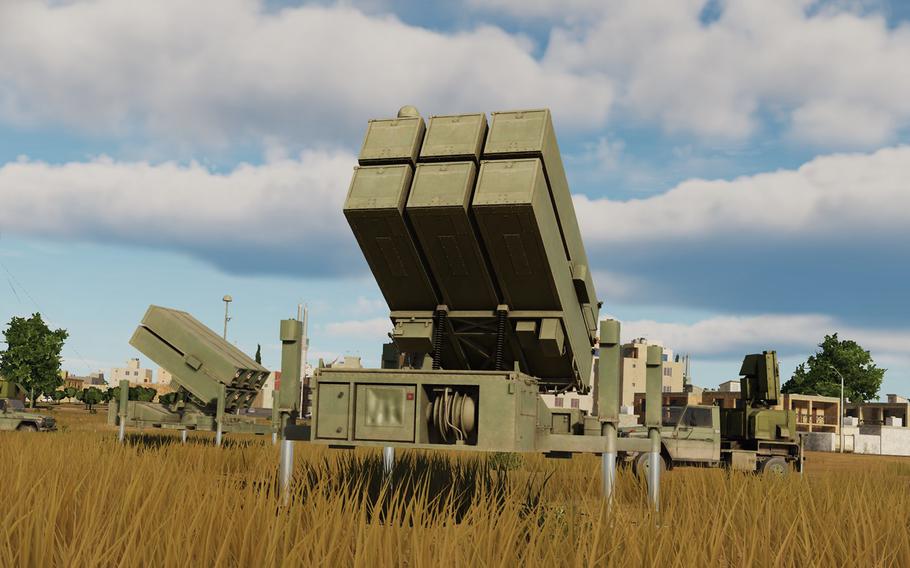
Washington already had provided Ukraine with NASAMS, a system meant to counter air-breathing threats such as cruise missiles, drones and aircraft, prior to Russia’s recent cruise missile attacks. (Facebook)
President Joe Biden has already pledged to provide air defense to Ukraine in the wake of Russia’s series of cruise missile strikes. At first glance, this seems appropriate. Air defense can mitigate the threat from missiles, drones and warplanes. But in Ukraine’s context, these weapons would be more useful on paper than in reality.
Ukraine’s front line is roughly 1,553 miles. This is too vast of a front line to defend from air and missile attacks, and Ukraine has to worry about these attacks in its rear, too. Even the most technologically advanced air defense systems wouldn’t be able to protect Ukraine’s 600,000 square kilometers of territory. And Ukraine’s own air defenses are too lacking for this gap to be bridged by any outside aid.
Ukraine’s current air defense arsenal consists of outdated Soviet technology, namely Soviet S-8 and S-300 systems sourced from the United States and Slovakia, its own stockpile of S-300 and Bu-Mk1 (also known as S-11) systems, and some short-range air defense systems such as Tor-Ms, Strela-10s, Osa-AKMs and Tunguskas.
Despite this myriad of systems, only the S-300 has the capability to protect against long-range threats, and even this system can be overwhelmed by saturation attacks like the barrage that Russia has launched in recent days. The rest of these systems are designed for pinpoint defense of assets or to protect a maneuvering army unit. None of these can stop the type of threat that Ukraine now faces.
Likewise, the aid that Washington and Europe have furnished aren’t on the scale that would alleviate this threat. Washington had already provided NASAMS, a system meant to counter air-breathing threats such as cruise missiles, drones and aircraft, prior to the recent cruise missile attacks. Germany has likewise sent IRIS-T systems, though these too are designed for pinpoint defense rather than protecting large areas.
The reality is technology currently favors the attacker when it comes to missiles and air attacks. Just as Britain had no counter to the V-2 in 1945, in 2022 we have no silver bullet. As air defenses improve, attackers respond with countermeasures. In the current technological balance, it’s easier for missiles to evade detection and interception than it is to stop them. That reality will change, but it is not the reality with which we must contend today.
Technology is imperfect, too. Machines break. Complex systems, dependent on a web of the generators, networking devices, radars, launchers and operating stations, have many fail points. And the expertise to fix and maintain this equipment cannot be given as easily as the equipment itself. Ukraine can be given equipment, but its operators won’t have the knowledge to use them. Overcoming this would take months under optimal conditions, and the problem is exacerbated by the variety of systems from different countries.
Ukraine lacks command of the air, which means it likely cycles its radars to avoid revealing Ukrainian positions to Russian air or artillery. The Serbians used this same tactic to hide their air defenses from NATO fighters in 1998. But this also means detection and interception aren’t possible unless Ukraine is willing to expose its most expensive assets to attack. Donated weapon systems might be rendered expensive paperweights because of Ukrainian risk aversion and the reality of the current battlefield.
Washington should also resist the inclination to try to be Ukraine’s one-stop-shop for military aid, even as Ukrainian officials add to their $27 billion shopping list. Russia does not see a distinction between defensive and offensive weapons, even if western planners do. And these systems, though defensive at the tactical level, enable offensive actions at the strategic level. Russia has railed against the U.S. anti-missile shield in Europe for years, which it believes undermines deterrence. Exacerbating this fear may cause Russia to lash out further, a dangerous risk given the threat of a tactical nuclear weapon being used.
Ukraine can adopt two approaches, one military and one diplomatic. Though active defense measures can’t offset Russia’s offensive missile advantage, passive measures can mitigate it. This means dispersing command and control systems, camouflaging forces, and hardening facilities to air attack. To prevent civilian casualties, this also means disentangling military forces from civilians, as Amnesty International has noted.
The second approach is to open the possibility to a cease-fire and negotiations. Ukrainian aspirations to retake all of their lost territory militarily ignores battlefield realities and lengthens the ongoing carnage devastating Ukraine’s population and infrastructure.
Negotiation is not capitulation. It may be Ukraine’s only chance to stay independent and avert nuclear catastrophe. The U.S., Germany and Turkey have all pushed for a cease-fire, but these words ring hollow as the West’s unceasing military aid enables Kyiv’s recalcitrance.
The United States gains nothing from sending air defense systems to Ukraine, and Ukrainians will face the same missile threat regardless. A Russia that has exhausted all its options is dangerous, particularly as Vladimir Putin feels pressure to produce a military victory at any cost. Further dampening Russia’s conventional capabilities makes the use of a nuclear weapon more likely.
Russia’s military has fumbled on the battlefield repeatedly. Given this reality, the United States should stop overreacting to Russia’s lackluster conventional capabilities while underemphasizing the nuclear risks. As the risk of escalation grows, its more prudent than ever for Washington to deescalate.
Geoff LaMear is a Fellow at Defense Priorities.